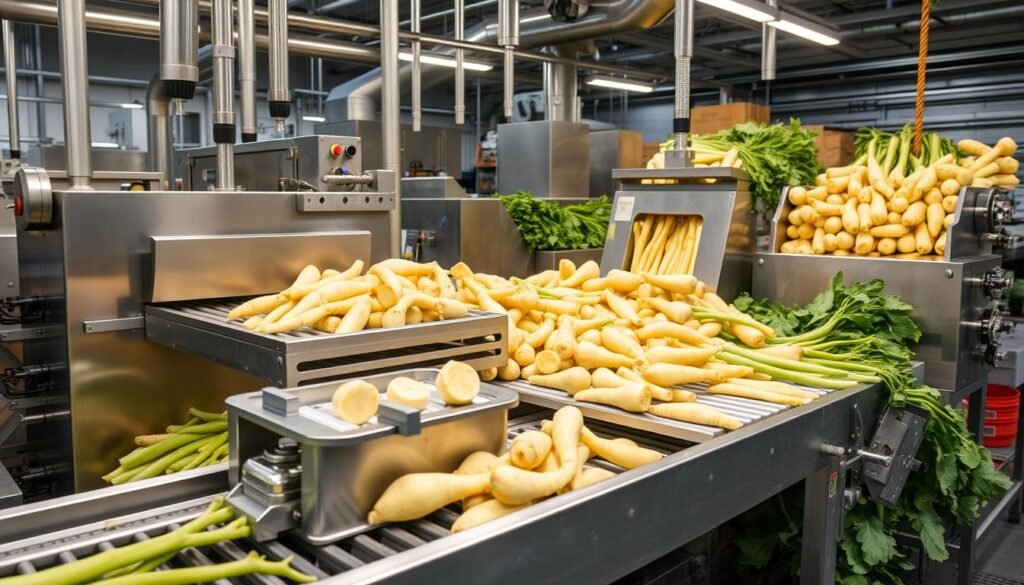Did you know the humble swede could lead to many new food products? As we explore swede processing, we see how this root veggie is key in value-added production. With more people wanting fresh, healthy foods, learning about swede processing is crucial.
From washing and peeling machines to cutting and slicing tools, there are many ways to improve our production. These advancements help us meet changing consumer tastes.
In this journey, we’ll learn how swedes become exciting products like chips and pickles. Join us as we dive into swede processing and discover the opportunities in this growing market.
Key Takeaways
- Swede processing involves various techniques that enhance product quality and sustainability.
- The use of washing and peeling machines streamlines production and reduces waste.
- Advanced cutting and slicing equipment maximises yield, improving overall efficiency.
- There’s a growing trend for value-added swede products in contemporary culinary practices.
- Embracing technology in swede processing opens new avenues for market engagement and product innovation.
Understanding Swedes: Varieties and Historical Context
The history of swedes is both rich and fascinating. It started in Sweden, where it was first grown. This vegetable has been a key part of European diets for centuries. It’s valued for its hardiness and versatility.
Exploring its history helps us see how swedes have shaped various cuisines. They’ve become a key ingredient in many traditional dishes.
The Origin of Swede in Culinary History
Swedes, also known as rutabagas, have a long history in cooking. They were first grown for their nutritional value and unique taste. In the Middle Ages, they were a common food, often used in stews or mashed with potatoes.
As trade grew, so did the use of swede varieties. This enriched diets and added to local cuisines around the world.
Popular Varieties of Swedes
Today, many swede varieties are grown globally. Each has its own flavour and uses in cooking. Some popular ones include:
- American Purple Top: Known for its purple crown and yellow flesh, it’s sweet and great for roasting or mashing.
- Yellow Ruta: A classic choice with a strong flavour and creamy texture, perfect for soups and pot pies.
- Midwinter: This variety is hardy and thrives in cold climates, with excellent storage capabilities.
Knowing these varieties is key for anyone interested in rutabaga processing. They greatly affect the taste, texture, and uses of the final product.
| Swede Variety | Characteristics | Culinary Uses |
|---|---|---|
| American Purple Top | Purple crown, sweet | Roasting, mashing |
| Yellow Ruta | Robust flavour, creamy | Soups, pot pies |
| Midwinter | Hardy, excellent storage | Stews, casseroles |
Swede Processing: Techniques, Products, and Opportunities in Value-Added Production
Exploring swede processing reveals many techniques and opportunities for value-added products. These methods turn raw swedes into tasty dishes that meet today’s food demands. The right equipment is key, ensuring quality and efficiency at every step.
Significant Techniques in Swede Processing
We use several key swede processing techniques to improve quality and look. These include:
- Washing: Cleaning swedes well before processing removes dirt and harmful stuff.
- Peeling: Careful peeling boosts looks and taste.
- Cuts and Slices: Advanced equipment helps us cut and slice evenly, important for cooking and packaging.
- Innovative Processing: Methods like blanching and freezing keep products fresh longer and keep nutrients in.
Value-Added Products from Swede
Creating value-added swede products is a big opportunity. We’ve found exciting options like:
- Swede Chips: A tasty, crispy snack for those looking for healthier choices.
- Pre-Packaged Swede Snacks: Products made for busy lives, easy to grab and go.
- Flavoured Mash: A tasty, ready-to-eat mash that mixes swedes with favourite flavours.
This variety meets new food trends and opens up profitable chances for us. By using new swede processing methods and top-notch equipment, we can turn simple swedes into popular dishes.
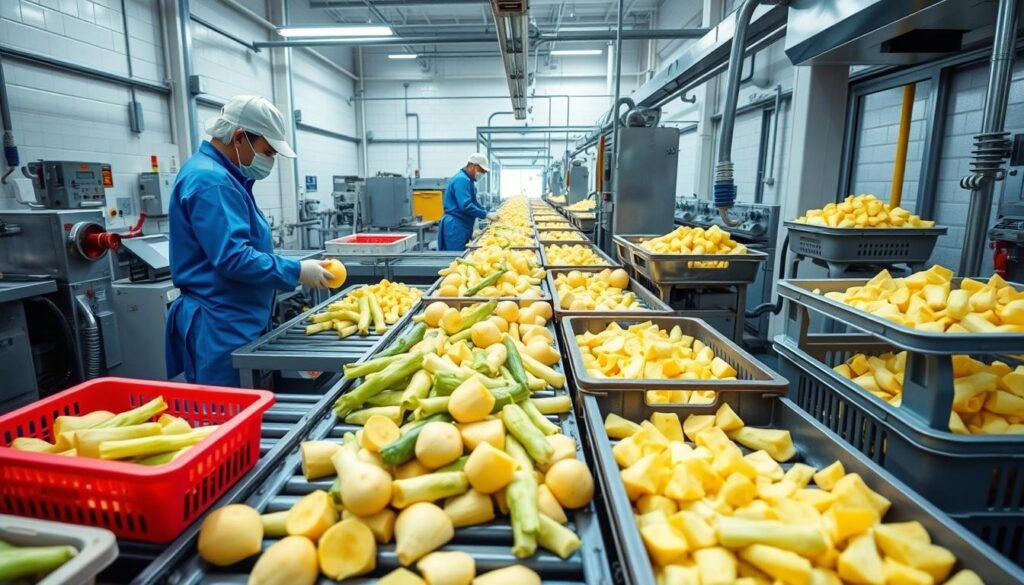
Importance of Washing and Peeling Machines in Swede Processing
Washing and peeling machines are key in making swede processing better. They clean and peel swedes well, making sure they are free from dirt and bacteria. This leads to better products and more efficient work.
How Washing and Peeling Machines Enhance Efficiency
Using advanced washing and peeling machines boosts efficiency a lot. They can make swede products 15% more than raw materials. Also, washing swedes right can make them last 25% longer in the market.
Water-saving washing systems can cut water use by 30%, saving money and the environment. Automation makes work 40% faster, helping businesses grow without needing more resources. Better washing also cuts down on bad swede products from 10% to 2%, saving on labour costs by 20%.
Top Features to Consider When Choosing Machinery
When picking washing and peeling machines, look for these key features:
- Speed: Choose machines that can work fast, like peeling 28 potatoes in 60 seconds.
- Capacity: Make sure the machine fits your production needs.
- Water Efficiency: Pick systems that use less water for a greener operation.
- Maintenance: Go for machines that are easy to clean and maintain, cutting down on downtime.
- Hygienic Design: It’s important to meet food safety standards, aiming for over 95% compliance.
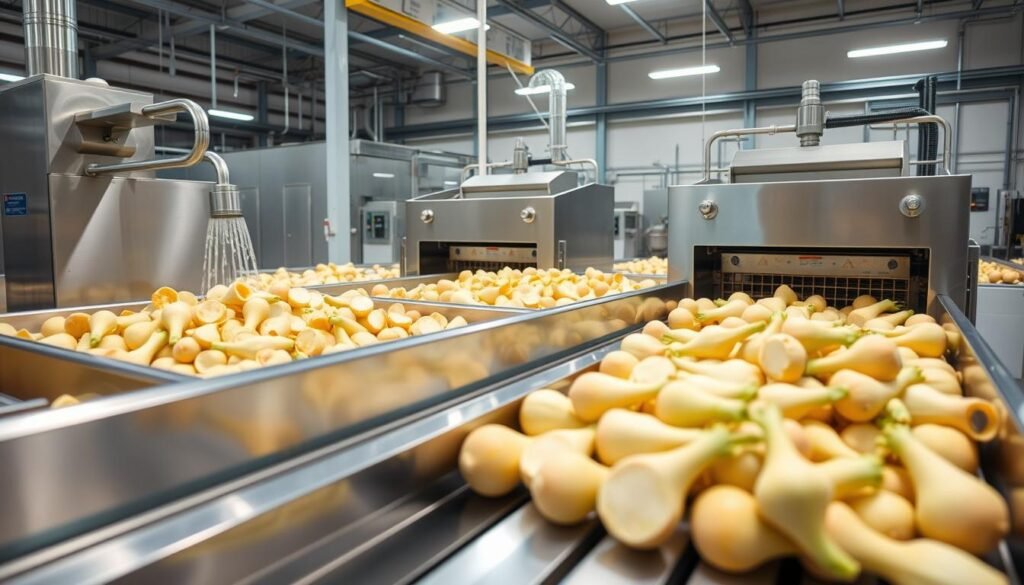
Adding these features will boost swede processing efficiency and quality. It ensures your products meet high standards and customer expectations.
Cutting and Slicing Equipment: Key to Successful Production
In our quest for swede processing excellence, cutting and slicing equipment is crucial. These tools are key to turning raw swedes into products that meet market needs. They help us get the most out of each swede and cut down on waste.
The Role of Cutting Equipment in Swede Processing
Good cutting equipment is essential for top-notch swede processing. The right machines affect both how fast and well we work, and the quality of what we make. For example, they need to handle different swede sizes and shapes to keep batches consistent.
Using the latest technology, cutting machines can make our work more efficient. They help us make products that are the same every time.
Innovative Slicing Techniques for Maximum Yield
New slicing techniques are changing how we process swedes. They focus on precision to get the most out of each swede. Features like fast rotation and adjustable thickness help us work faster and lose less product.
Brands like Li An Machinery and FTNON offer top-notch machinery. Their equipment boosts performance and meets strict hygiene standards, vital for today’s processing needs.
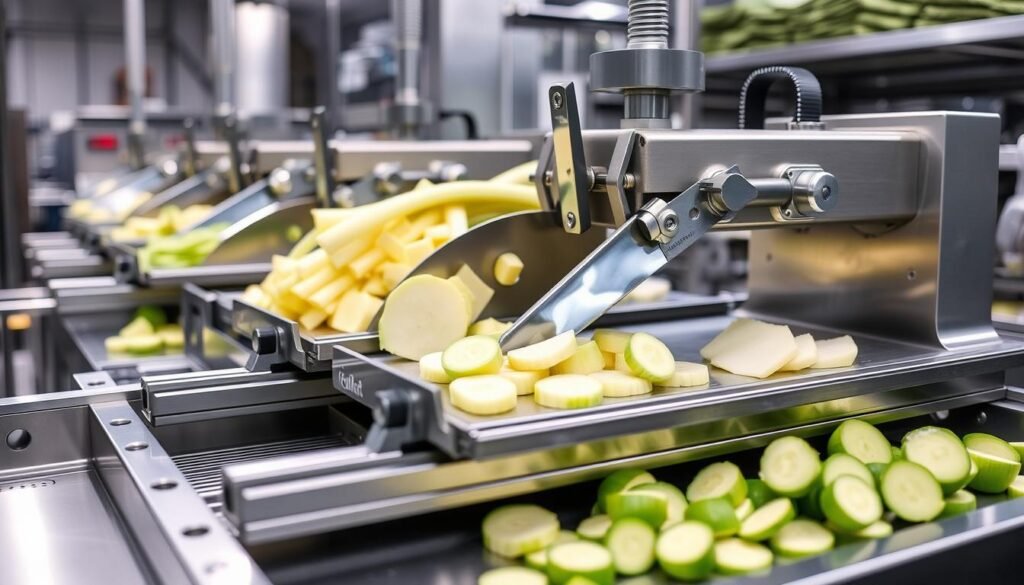
Investing in the right cutting and slicing equipment can save a lot of money. These innovations improve how we work and meet growing demand for quality swede products. Our focus on getting the best equipment helps us stay competitive and deliver great products to our customers.
Deep Processing: Creating Products from Swedes
Deep processing of swedes lets us make exciting products. These products are tasty and fit modern diets. It makes swedes more versatile, turning them into innovative snacks and gourmet ingredients.
Exploring Deep Processed Products Like Swede Chips
Swede chips are a hit as a healthier snack. They’re made by slicing swedes thinly and frying them carefully. This keeps their natural taste and adds crunch.
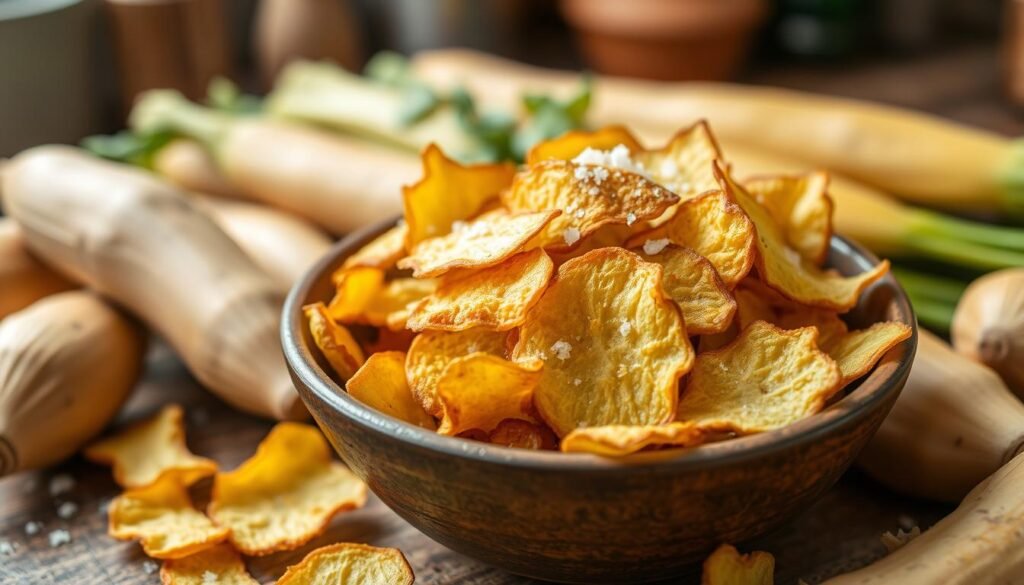
The Star Wheel Fryer has improved swede chip making. It fries evenly and quickly, making large batches. This machine can fry 100 to 750 kg of chips per hour.
Pickled Swede: A Trendy Ingredient in Modern Cuisine
Pickled swede is now a trendy ingredient. It’s preserved with spices, adding vibrant flavours. Chefs and home cooks use it in salads, sandwiches, and charcuterie boards.
Using old and new methods, pickled swede can be a star in many dishes. It’s perfect for those looking for unique tastes and healthy options.
| Product | Processing Method | Benefits |
|---|---|---|
| Swede Chips | Deep Fried | Higher Nutritional Value, Lower Calories |
| Pickled Swede | Brining | Extended Shelf-Life, Enhanced Flavour |
The Technology Behind Effective Swede Processing
We are on the edge of a new tech era that boosts vegetable processing, especially swede processing. New machines make work easier and quality better. They also meet the growing need for fast and efficient ways to process.
Modern Innovations in Vegetable Processing Equipment
New tech in swede processing brings automated systems to improve how we work. Key changes include:
- Automated sorting: This tech sorts swedes by size and quality, cutting down on manual work.
- Digital monitoring systems: These systems give us live updates on production, helping us make quick changes.
- Smart machinery: Machines that can change with the demand make processing more flexible.
The Impact of Technology on Processing Efficiency
Advanced equipment is key to making processing better. With new tech in swede processing, we see:
- Reduced waste: Better sorting and cutting mean less waste and more sustainability.
- Improved speed: Automated systems make processing faster, getting products out quicker.
- Enhanced quality control: Monitoring and precise settings ensure swedes meet quality standards.
The market for food processing equipment is expected to grow a lot. Companies like Li An Machinery and GEA Group show the push for new ideas. Investing in modern equipment is crucial for staying ahead.
| Type of Equipment | Function | Benefits |
|---|---|---|
| Automated Sorters | Sort swedes by size and quality | Increases efficiency and reduces manual labour |
| Digital Monitoring Systems | Track production in real-time | Enables quick adjustments for optimal performance |
| Smart Machinery | Adapt to variety in production | Enhances flexibility and maximises output |
Opportunities in Value-Added Production from Swedes
The demand for swede products is growing fast. People want healthier, local food options. Businesses can benefit by understanding market trends and tapping into new opportunities.
Market Trends for Value-Added Swede Products
The global food processing equipment market was worth $54.9 billion in 2021. It’s expected to hit $76.56 billion by 2028, growing at 5.7% annually. The Asia Pacific leads, driven by economic growth and processed food demand.
The market for processing fruits and vegetables is also booming, with a 6.28% growth rate from 2021 to 2028. This shows a growing interest in swede products. It’s becoming a key ingredient for health-conscious and gourmet foods.
How to Tap into Niche Markets with Swede Products
Identifying niche markets can boost swede product popularity. North America is seeing growth in packaged and frozen foods, where swedes can shine. It’s crucial to partner with distributors who get these trends.
- Focus on health-conscious consumers – Promote swede products that are organic, gluten-free, or vegan.
- Gourmet snacks – Create unique, upscale snack options incorporating swedes, appealing to a high-end market.
- Convenience products – Develop ready-to-eat and easy-to-cook options to tap into busy lifestyles.
By focusing on these areas, we can make the most of the food processing market. New equipment and techniques can improve swede product appeal for quality-seeking consumers.
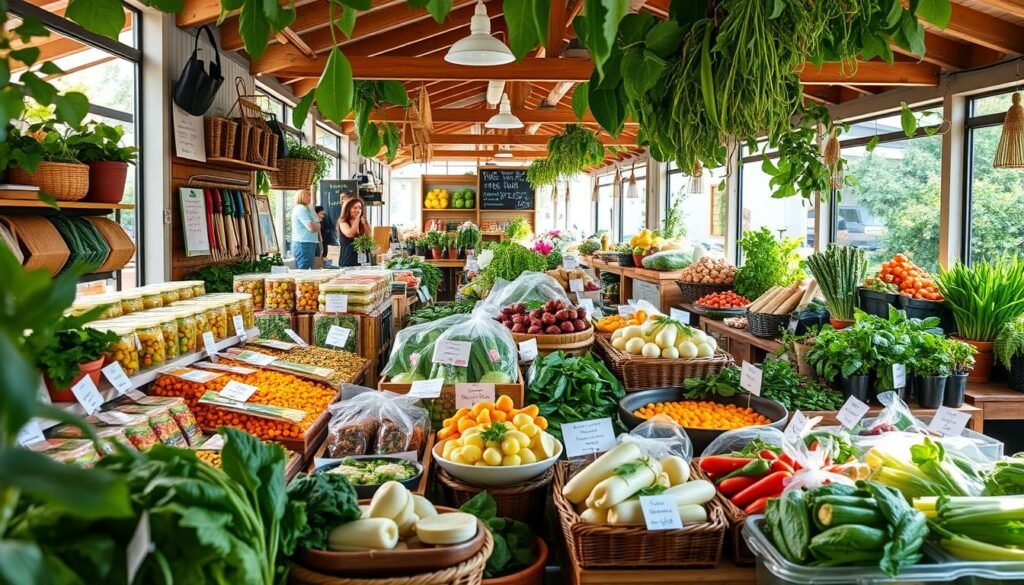
| Region | Market Growth Rate | Key Factors |
|---|---|---|
| Asia Pacific | Leading region in revenue growth | High food consumption rates |
| North America | Significant CAGR due to disposable income | Increased demand for frozen products |
| Global Food Processing | 5.7% CAGR from 2022 to 2028 | Advancements in automation |
| Fruits and Vegetables Processing | 6.28% growth expected | Rise in exotic fruit consumption |
Conclusion
Swede processing is key in both farming and cooking. The demand for fresh fruits and veggies is growing fast. This means we need to focus more on adding value to our products.
Learning new techniques and using the right equipment helps us work better and greener. This makes our work more efficient and sustainable.
We’re all about keeping up with new machines, like Li An’s Root Vegetable Cutting Machine. It helps us stay ahead in the fast-changing world of swede processing.
It’s also crucial to handle swedes right, keep things clean, and control temperature and humidity. This is especially important for products that spoil quickly.
We’re excited to create more chances for adding value to our work. By using technology wisely and focusing on sustainability, we can meet the demand for healthy food. We also aim to make our industry better for the future.
FAQ
What is swede processing, and why is it important?
Swede processing is about cleaning, peeling, cutting, and cooking swedes into tasty products. It makes food better, keeps it fresh longer, and meets the demand for healthy food.
What are the key techniques in swede processing?
Key steps include washing, peeling, cutting, and cooking swedes. These steps help turn swedes into chips and pickles.
Which machines are essential for effective swede processing?
Important machines include those for washing, peeling, cutting, and cooking. These tools make the process faster and the food better.
What are some popular varieties of swedes grown in Australia?
In Australia, “American Purple Top” and “Yellow Ruta” swedes are favourites. They add unique tastes and textures to our dishes.
How do washing and peeling machines improve swede processing?
Washing and peeling machines save time and effort. They also keep the swedes clean, which is key for quality.
Can technology impact the efficiency of swede processing?
Yes, technology boosts swede processing efficiency. New tools like automated sorting machines help make more food, waste less, and are better for the planet.
What are the benefits of deep processing swedes?
Deep processing turns swedes into tasty items like chips and pickles. This increases variety, keeps food fresh longer, and adds value.
What market trends should we be aware of regarding value-added swede products?
People want healthy, local food more than ever. This trend boosts demand for swede products like gluten-free snacks, offering chances for businesses to meet consumer needs.
Source Links
- Application of Processing and Packaging Hurdles for Fresh-Cut Fruits and Vegetables Preservation – https://pmc.ncbi.nlm.nih.gov/articles/PMC8068883/
- Freezing of fruits and vegetables – https://www.fao.org/4/y5979e/y5979e03.htm
- GEA and PeelPioneers use orange peel to cut food waste – https://www.gea.com/en/customer-cases/the-appeal-of-peel-to-reduce-food-waste/
- PDF – https://www.srs.fs.usda.gov/pubs/ja/ja_mcmillin029.pdf
- Fruit and Vegetable Processing Market Trends, Revenue Forecast – 2027 – https://www.marketsandmarkets.com/Market-Reports/fruit-vegetable-processing-market-140232885.html
- Fruit And Vegetable Processing Global Market Report 2025 – https://www.thebusinessresearchcompany.com/report/fruit-and-vegetable-processing-global-market-report
- PDF – https://hortscans.ces.ncsu.edu/uploads/m/i/minimal__51376c96a84fa.pdf
- Line and individual solutions for the foodstuff industry – https://www.weberweb.com/portfolio/
- PDF – https://www.jetir.org/papers/JETIR1905J57.pdf
- Rosenqvists Fryers | KayDee Solutions – https://kaydeesolutions.com/process-solutions/rosenqvists-fryers/
- Preparation and handling of fresh-cut root vegetables – https://www.academia.edu/66563125/Preparation_and_handling_of_fresh_cut_root_vegetables
- What is Food Processing | FHA-FnB – https://fhafnb.com/glossary/food-processing/

